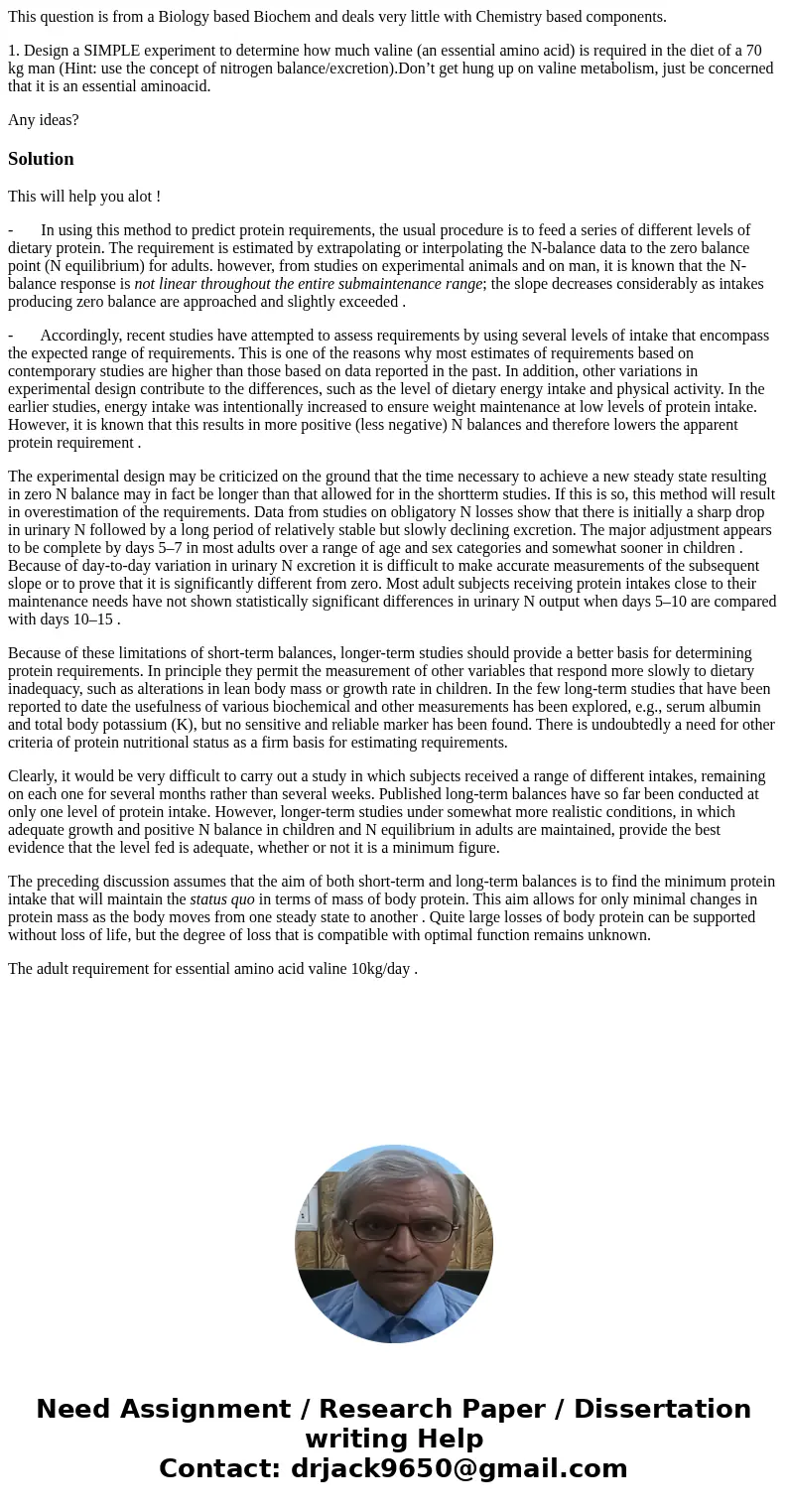This question is from a Biology based Biochem and deals very
This question is from a Biology based Biochem and deals very little with Chemistry based components.
1. Design a SIMPLE experiment to determine how much valine (an essential amino acid) is required in the diet of a 70 kg man (Hint: use the concept of nitrogen balance/excretion).Don’t get hung up on valine metabolism, just be concerned that it is an essential aminoacid.
Any ideas?
Solution
This will help you alot !
- In using this method to predict protein requirements, the usual procedure is to feed a series of different levels of dietary protein. The requirement is estimated by extrapolating or interpolating the N-balance data to the zero balance point (N equilibrium) for adults. however, from studies on experimental animals and on man, it is known that the N-balance response is not linear throughout the entire submaintenance range; the slope decreases considerably as intakes producing zero balance are approached and slightly exceeded .
- Accordingly, recent studies have attempted to assess requirements by using several levels of intake that encompass the expected range of requirements. This is one of the reasons why most estimates of requirements based on contemporary studies are higher than those based on data reported in the past. In addition, other variations in experimental design contribute to the differences, such as the level of dietary energy intake and physical activity. In the earlier studies, energy intake was intentionally increased to ensure weight maintenance at low levels of protein intake. However, it is known that this results in more positive (less negative) N balances and therefore lowers the apparent protein requirement .
The experimental design may be criticized on the ground that the time necessary to achieve a new steady state resulting in zero N balance may in fact be longer than that allowed for in the shortterm studies. If this is so, this method will result in overestimation of the requirements. Data from studies on obligatory N losses show that there is initially a sharp drop in urinary N followed by a long period of relatively stable but slowly declining excretion. The major adjustment appears to be complete by days 5–7 in most adults over a range of age and sex categories and somewhat sooner in children . Because of day-to-day variation in urinary N excretion it is difficult to make accurate measurements of the subsequent slope or to prove that it is significantly different from zero. Most adult subjects receiving protein intakes close to their maintenance needs have not shown statistically significant differences in urinary N output when days 5–10 are compared with days 10–15 .
Because of these limitations of short-term balances, longer-term studies should provide a better basis for determining protein requirements. In principle they permit the measurement of other variables that respond more slowly to dietary inadequacy, such as alterations in lean body mass or growth rate in children. In the few long-term studies that have been reported to date the usefulness of various biochemical and other measurements has been explored, e.g., serum albumin and total body potassium (K), but no sensitive and reliable marker has been found. There is undoubtedly a need for other criteria of protein nutritional status as a firm basis for estimating requirements.
Clearly, it would be very difficult to carry out a study in which subjects received a range of different intakes, remaining on each one for several months rather than several weeks. Published long-term balances have so far been conducted at only one level of protein intake. However, longer-term studies under somewhat more realistic conditions, in which adequate growth and positive N balance in children and N equilibrium in adults are maintained, provide the best evidence that the level fed is adequate, whether or not it is a minimum figure.
The preceding discussion assumes that the aim of both short-term and long-term balances is to find the minimum protein intake that will maintain the status quo in terms of mass of body protein. This aim allows for only minimal changes in protein mass as the body moves from one steady state to another . Quite large losses of body protein can be supported without loss of life, but the degree of loss that is compatible with optimal function remains unknown.
The adult requirement for essential amino acid valine 10kg/day .

 Homework Sourse
Homework Sourse